m (→Ranged support: missed this) |
m (→Assassins: I'm just really terrible at proofreading apparently. I proofread this paragraph, even revised it, only to still find these errors again moments after publishing) |
||
| Line 79: | Line 79: | ||
==Military units== |
==Military units== |
||
===Assassins=== |
===Assassins=== |
||
| − | The [[Levantine Brotherhood of Assassins|Assassin state]] that emerged in 1050 under the leadership of [[Hassan-i Sabbāh]] established several conventional military units even though the average Assassin was trained from birth to serve as covert operatives.<ref name="AC1guide" /><ref name="ACAC" /><ref name="tEG">''[[Assassin's Creed: The Essential Guide]]''</ref> These soldiers would be charged with defending their homes with their lives in the event |
+ | The [[Levantine Brotherhood of Assassins|Assassin state]] that emerged in 1050 under the leadership of [[Hassan-i Sabbāh]] established several conventional military units even though the average Assassin was trained from birth to serve as covert operatives.<ref name="AC1guide" /><ref name="ACAC" /><ref name="tEG">''[[Assassin's Creed: The Essential Guide]]''</ref> These soldiers would be charged with defending their homes with their lives in the event of a frontal assault against the Assassin citadels,<ref name="AC1guide" /> as was the case during the [[Siege of Masyaf]] in 1176.<ref name="TSC" /> |
| − | Among these guardsmen were the [[Ceremonial Guard]], who wielded glaives, and the heavy infantrymen, who wielded swords. The latter were fully clad in armor. first a hauberk over their robes, then a breastplate of scale armor with corresponding shoulder guards for added protection. A Persian-style ''{{wiki|spangenhelm}}'' complete with a firmly-sealed, plated visor masked their entire face. In contrast, the Ceremonial Guard donned little more than the typical robes and beaked hood of their people, only wearing a red-rimmed cloak and a face veil for distinction.<ref name="AC1guide" /> Aside from these two units, other Assassins would serve as common soldiers when forced into open battle.<ref name="AC1" /><ref name="ACR" /><ref name="AC1guide" /> Crossbowmen and archers manned their walls and lookout posts.<ref name=" |
+ | Among these guardsmen were the [[Ceremonial Guard]], who wielded glaives, and the heavy infantrymen, who wielded swords. The latter were fully clad in armor. first a hauberk over their robes, then a breastplate of scale armor with corresponding shoulder guards for added protection. A Persian-style ''{{wiki|spangenhelm}}'' complete with a firmly-sealed, plated visor masked their entire face. In contrast, the Ceremonial Guard donned little more than the typical robes and beaked hood of their people, only wearing a red-rimmed cloak and a face veil for distinction.<ref name="AC1guide" /> Aside from these two units, other Assassins would serve as common soldiers when forced into open battle.<ref name="AC1" /><ref name="ACR" /><ref name="AC1guide" /> Crossbowmen and archers manned their walls and lookout posts.<ref name="TSC" /><ref name="ACAC" /> |
==Appearances== |
==Appearances== |
||
Revision as of 12:50, 10 August 2019

|
Patience, brothers. Soon we will reveal the secrets of Assassin's Creed: Unity, Assassin's Creed Chronicles: China, Assassin's Creed Chronicles: India, Assassin's Creed Chronicles: Russia, Assassin's Creed: Origins, and Assassin's Creed: Odyssey. This article has been identified as being out of date. Please update the article to reflect recent releases and then remove this template once done. |
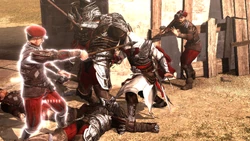
Ezio Auditore fighting several Borgia guards
A soldier is a combatant serving in a military. Their basic duties are to defend their community and conduct warfare against the enemies of their leaders. Prior to the widespread creation of police forces, civilian enforcers of the law, public order in cities were invariably maintained by soldiers, in which capacity they were commonly referred to as guards.[1][2]
Because they are almost always necessary to the survival of a people, soldiers have been ubiquitous throughout the history of civilization. In service to a state, in which case they constitute the state's military, they are the individuals entrusted with the legitimate use of force by the government. Not limited to national armies, they have also been recruited, trained, and fielded by unconventional groups with military arms, such as rebel factions and most prominently the transnational secret organizations of the Templar Order and the Assassin Brotherhood. It was not unknown for mercenaries, particularly during the Italian Wars, to form themselves into armies as well.
In response to the diverse demands of war, militaries throughout history have typically organized their soldiers into hierarchies with a clear chain of command along with specialized units suited to different combat situations. Aside from the broader categories of infantry and cavalry, common, narrower specializations prior to the advent of firearms included lightly armored skirmishers like the Athenian peltasts, powerful yet sluggish brutes, frontline pikemen, and professionally trained archers and crossbowmen. For the protection of the most vital people, like the state rulers themselves, special elite units of the highest calibre were frequently established, with infamous examples being the Swiss Guards of the Papal States and the Janissaries of the Ottoman Empire.
The Assassins themselves classified enemies into basic archetypes, employing nicknames like "seekers" or "defenders" for polearm-wielding guards, "grunts" for the most mediocre soldiers, and "snitches" for non-combatant personnel likely to flee and call for reinforcements.
Common classifications
While soldiers across human history have varied immensely in their training, equipment, and technology, certain classifications have been employed almost universally.[2][3][4] Among these is the division between infantry, cavalry, and artillery, denoting foot-soldiers, horsemen, and siege weapons respectively. Infantry, in turn, may take the form of close-ranged combatants, such as pikemen or swordsmen, or long-ranged support, such as archers, crossbowmen, and snipers.[5]
Militaries often categorized their infantry units into light, standard, and heavy infantry,[6] but the Assassin Brotherhood usually identified enemy soldiers as falling into the basic generalities of regulars, brutes, agiles, and seekers.[2][3][7]
Regulars
- Main article: Regular
Regulars are the standard unit of infantry in militaries. As the backbone of their forces, they constitute the average in their capabilities without any specialization and are serviced with the most standard equipment of their army, be it a sword, spear, musket, etc.[6][7][8]
Brutes
- Main article: Brute
The aptly-named brutes distinguish themselves with their particularly bulky, sturdy physique. Frequently utilizing heavy weapons like battleaxes or bastard swords, these combatants rely upon their great strength to overpower their enemies at the cost of speed and agility.[2][7] Brutes are not a uniform type of soldier but constitute a common stereotype of any non-elite, heavy infantry embodying these traits, with units as diverse as Spartan hypatists,[6] Byzantine Almogavars,[9] and British grenadiers falling under this label.[7]
Agiles
- Main article: Agile
Lightly armored soldiers serving as scouts or trackers are also known as agiles because they forsake standard military equipment for maximum mobility. In combat situations, they are trained to engage foes with flurries of swift attacks and rely on evasive manoeuvres to compensate for their little to no protection. Their survivability contingent on their nimbleness, agiles were almost always the most athletic of their forces, with some, as was the case among Borgia guards, even being trained in parkour.[2] While the relatively mundane British scout was a typical example of an agile,[7] ancient warriors like the fearsome Cult of Kosmos scions and the Ptolemaic predators also filled this role to an extent.[4][6]
Seekers
- Main article: Seeker
With stealth being a hallmark of Assassin operations, their agents frequently nicknamed enemy soldiers in charge of scouring hiding spots "seekers". Seekers throughout Assassin history shared little commonalities beyond this, varying wildly in their equipment and training. The seekers as classified by the Italian Brotherhood during the Renaissance were armored spearmen while those designated by the Chinese Brotherhood of the Ming dynasty wielded light swords and carried shuriken.[8][10][11] The trend continued into the 19th century, where the Parisian Brotherhood recognized experienced fencers equipped with crowd control tools like flash bombs as their enemy seekers.[3] Regardless, seekers have invariably been soldiers of greater martial skill and military authority than regulars, brutes, and agiles.[2][3][11]
Ranged support
Archers were a mainstay of human armies prior to their discovery of firearms. These bowmen were vital to the defence of cities and fortresses, as their ability to attack from afar with hails of arrows allowed them to soften invasion forces before direct confrontation.[12] In smaller scale skirmishes, the principle remained the same: ranged units provided support to their comrades engaged in mêlée with the enemy.[1][2][4][6]
While the bow was the weapon of choice for this role through much of human history, advancements in technology eventually led to them being superseded by those that could deliver greater firepower. The crossbow saw widespread usage among Crusaders in the 12th century,[13] but the Chinese, who invented the repeating crossbow, had already implemented it as early as the 4th to 3rd century BCE.[14] Although it was heavier and had shorter range, it boasted superior penetrating power.[9][12] It did not phase out the bow, however, which was an eventuality that came with the advent of firearms.[7][15]
In conjunction with archers and crossbowmen, the Ming dynasty fielded handcannon guards while the Papal States at the beginning of the 16th century introduced arquebusiers.[8][11] With longer range and greater lethality, these marksmen were the precursors to snipers, whom the Assassins nicknamed "watchers".[3][16] Even when ranged weapons became the norm of all military units due to the indisputable superiority of modern firearms to mêlée weapons, the role of ranged support did not disappear; the distance between enemy combatants in engagements only widened. Snipers who could fire from distances far in excess of their archer predecessors have come to fulfill this position in modern warfare.[3][16][17]
Military ranks
Soldiers are normally organized into hierarchies within their militaries which define the chain of command.
Medieval armies
European and Saracen armies from the 12th century to at least the 16th century were roughly divided into four ranks signifying an increasing level of combat training and experience. Invariably, the higher-ranking soldiers were more heavily armored and better equipped than their subordinates regardless of the state fielding them. Even officers of the top tier, however, fell under the command of the noble, official, or private individual who either recruited them or that they were tasked to defend.[1][2][8]
Soldier
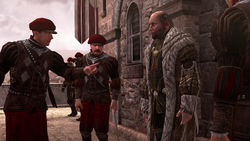
Three Militia guards cornering Egidio Troche
The vast majority of regular soldiers fighting in the Crusades lacked any commanding authority and were therefore commonly referred to simply as "soldiers" without qualification.[18] To avoid confusion, these soldiers were also called "Militia" by the Italian Brotherhood of Assassins during the Renaissance.[8] In essence, their rank was in not truly bearing one, and their inexperience and lack of discipline meant that they were especially vulnerable to deception and low morale. It was not uncommon for Militia to be led astray from pursuit or battle by the sight of loot on the ground, a weakness that was sometimes exploited by the Assassins.[2]
Given their low status, regular soldiers were provided with only the minimum standard of protection. Every Crusader soldier were equipped with chain-mail armor and a surcoat while their Saracen counterparts protected themselves with lamellar armor.[1] Likewise, European soldiers of the late 15th to early 16th century donned brigandines, yet in none of these cases were these regulars afforded helmets.[2][8]
Sergeant
Moderately better trained, sergeants were of a rank above regular soldiers and were normally not placed in charge of large operations. Instead, they might assume leadership of squads. Nonetheless, in one occasion during the Third Crusade, a Templar sergeant led a force of at least several dozen soldiers to sack a village by Alep.[19]
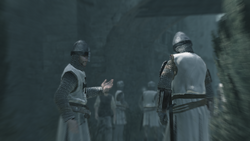
Two Teutonic sergeants talking
In addition to basic equipment, sergeants were serviced with light helmets, and it was by these that they could be identified. While more disciplined than the average soldier, sergeants were still often susceptible to breaking ranks at the sight of superiors being slain. Historically, the Assassins sometimes referred to soldiers of this rank as "Elites" despite them bearing a low rank and never constituting an elite force.[2][18]
Commander
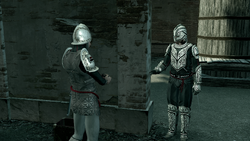
A Leader speaking with an Agile
Commanders,[18] also known generically as Leaders,[8][18] were among the most seasoned of soldiers. As the lieutenants of captains, they were entrusted with positions of command in their absence, and their presence could be vital for maintaining morale and discipline among their troops.[1][2][8] For identification, their enhanced armor were characterized by a fully enclosed helmet,[1][8] such as the iconic Crusader great helm.[1]
Captain
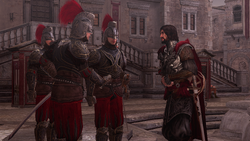
Cesare Borgia speaking with his Captains
In the Middle Ages, captains were the officers with the greatest authority absent elite forces such as the Papal Guard and the Janissary.[8][9] At other times, they were themselves synonymous with the elite units of their military.[1][10] Although still subordinate to the individual they rendered service to, be that a state official or even a private individual,[8][10] they comprised the highest command of armies and could be called to a council of war by their commander-in-chief.[13]
Among Crusader armies in the 12th century, the role of captain was filled by full-fledged knights.[13] Such was the case among the armies of the Knights Templar. These knights were by far the most exceptional warriors of their society, having honed their swordsmanship through a lifetime of training, and could prove a match for even elite Assassins.[1][13]
Similarly, guard captains of the Italian city-states and Iberian kingdoms in the late 15th century were trained to be an indomitable force. Selected for their colossal stature, these soldiers were deployed by the Spanish Inquisition and the Spanish Rite of the Templar Order to lead campaigns, defend their palaces, and hunt their enemies with impunity. They clad themselves in full plate armor in the manner of knights and conventionally wielded greatswords. The Emirate of Granada also employed captains of this calibre, many of which protected the Alhambra, though their armor was comparatively light.[10]
Not all captains of this era were of this archetype, however. Those in service to the House of Borgia and the French Army were more standard, being of average size and strength. Though professionally trained, they did not eclipse their subordinate comrades in martial might to the extent that Templar knights and Inquisition captains did, posing little challenge for Master Assassins.[8]
When not commanding army divisions in battle, captains could be assigned to other duties, such as overseeing the defence of a military zone in a city.[8][13] Under the rule of the Borgia during the papacy of Alexander VI, Rome was divided into twelve districts, each under the supervision of a Borgia captain.[8] Historically, the Templars were known to even deploy their captains as independent agents on covert operations.[1][10]
Military units
Assassins
The Assassin state that emerged in 1050 under the leadership of Hassan-i Sabbāh established several conventional military units even though the average Assassin was trained from birth to serve as covert operatives.[18][13][20] These soldiers would be charged with defending their homes with their lives in the event of a frontal assault against the Assassin citadels,[18] as was the case during the Siege of Masyaf in 1176.[5]
Among these guardsmen were the Ceremonial Guard, who wielded glaives, and the heavy infantrymen, who wielded swords. The latter were fully clad in armor. first a hauberk over their robes, then a breastplate of scale armor with corresponding shoulder guards for added protection. A Persian-style spangenhelm complete with a firmly-sealed, plated visor masked their entire face. In contrast, the Ceremonial Guard donned little more than the typical robes and beaked hood of their people, only wearing a red-rimmed cloak and a face veil for distinction.[18] Aside from these two units, other Assassins would serve as common soldiers when forced into open battle.[1][9][18] Crossbowmen and archers manned their walls and lookout posts.[5][13]
Appearances
References

- ↑ 1.00 1.01 1.02 1.03 1.04 1.05 1.06 1.07 1.08 1.09 1.10 Assassin's Creed
- ↑ 2.00 2.01 2.02 2.03 2.04 2.05 2.06 2.07 2.08 2.09 2.10 2.11 Assassin's Creed II
- ↑ 3.0 3.1 3.2 3.3 3.4 3.5 Assassin's Creed: Unity
- ↑ 4.0 4.1 4.2 Assassin's Creed: Origins
- ↑ 5.0 5.1 5.2 Assassin's Creed: The Secret Crusade
- ↑ 6.0 6.1 6.2 6.3 6.4 Assassin's Creed: Odyssey
- ↑ 7.0 7.1 7.2 7.3 7.4 7.5 Assassin's Creed III
- ↑ 8.00 8.01 8.02 8.03 8.04 8.05 8.06 8.07 8.08 8.09 8.10 8.11 8.12 8.13 Assassin's Creed: Brotherhood
- ↑ 9.0 9.1 9.2 9.3 Assassin's Creed: Revelations
- ↑ 10.0 10.1 10.2 10.3 10.4 Assassin's Creed II: Discovery
- ↑ 11.0 11.1 11.2 Assassin's Creed Chronicles: China
- ↑ 12.0 12.1 Assassin's Creed: Project Legacy
- ↑ 13.0 13.1 13.2 13.3 13.4 13.5 13.6 Assassin's Creed: Altaïr's Chronicles
- ↑ Assassin's Creed Chronicles: China – Database: Crossbow
- ↑ Assassin's Creed IV: Black Flag
- ↑ 16.0 16.1 Assassin's Creed: Syndicate
- ↑ Assassin's Creed: Uprising #12
- ↑ 18.0 18.1 18.2 18.3 18.4 18.5 18.6 18.7 Assassin's Creed: Official Game Guide
- ↑ Assassin's Creed: Altaïr's Chronicles – Coming Home
- ↑ Assassin's Creed: The Essential Guide
| ||||||||||||||||||||||||||||
| |||||||||||||||||||||||||||||||||||||
